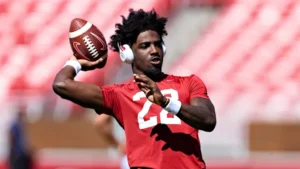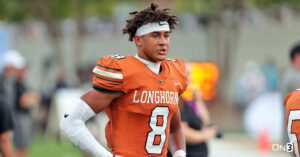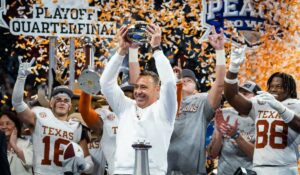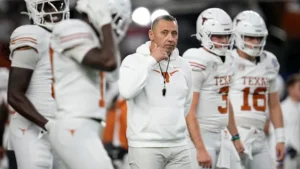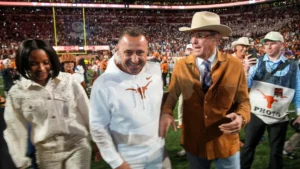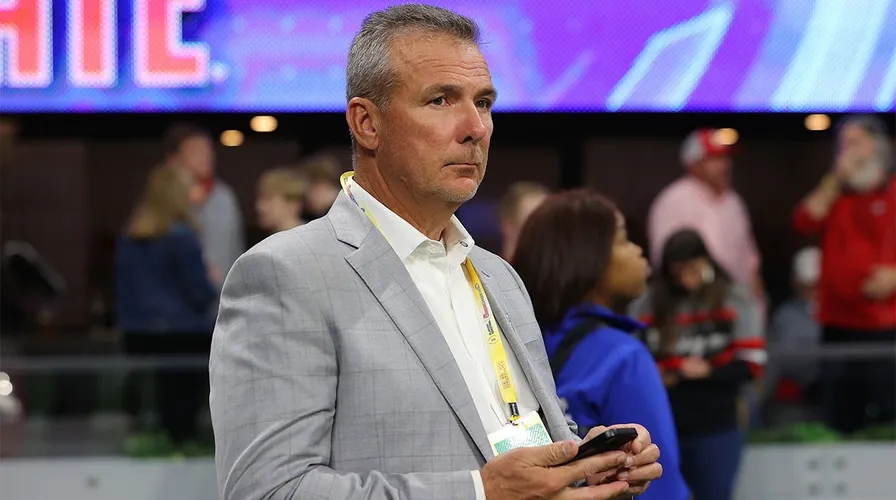
Urban Meyer’s response to Nico Iamaleava’s departure from the Volunteers because of the NIL rift: “Tennessee is in a bad spot.”
In the world of college football, where the sport’s tradition is as deep as the roots of the programs themselves, the introduction of NIL (Name, Image, and Likeness) has led to seismic shifts in how programs operate, recruit, and navigate player retention. No one has felt these shifts more than programs in high-demand recruiting areas such as Tennessee, a school that has seen great success in the past but has also encountered its share of challenges in modern college football. When Nico Iamaleava, a highly touted quarterback recruit, decided to leave the Tennessee Volunteers, citing issues with NIL, Urban Meyer’s comments—“Tennessee is in a bad spot”—sent ripples through the sport, reflecting the growing tension between traditional recruiting methods and the new landscape that NIL has ushered in.
The Impact of NIL on College Football
Before delving into Meyer’s specific comments, it’s important to understand the broader context of NIL and how it has influenced college football. The decision by the NCAA to allow athletes to profit from their name, image, and likeness marked a transformative moment for college sports. In a world where coaches and administrators had long been able to control the financial aspects of player recruitment—often without direct compensation to players themselves—NIL changed the playing field, giving players an avenue to earn money based on their fame, skill, and marketability.
At first, NIL seemed like a win-win situation, allowing athletes to benefit from their personal brand while remaining in school and participating in their respective sports. But as time has gone on, the unintended consequences of NIL have come to the forefront. The introduction of collectives—groups or organizations that pool funds to support athletes in exchange for endorsements, appearances, and other promotional activities—has fundamentally altered the recruiting process.
Top recruits, such as Iamaleava, have become increasingly aware of the financial incentives offered to them by various programs. These offers aren’t just based on a school’s football legacy or its development of athletes but on the financial potential an athlete can tap into while attending a particular university. This new reality has created a competitive arms race, where programs that have the financial resources to offer large NIL deals find themselves at an advantage, while schools with less funding or a less established NIL infrastructure may struggle to keep pace.
The Case of Nico Iamaleava
Nico Iamaleava, a five-star quarterback prospect from Long Beach, California, is one of the most high-profile players in his class. His decision to commit to Tennessee in 2022 was seen as a massive win for head coach Josh Heupel and the Volunteers program, as Iamaleava was considered a generational talent at the quarterback position. His skillset, arm strength, and poise under pressure made him a potential game-changer for Tennessee.
However, as with many other top recruits in this new NIL era, Iamaleava’s recruitment was significantly influenced by the NIL offers he received. Initially, Tennessee’s NIL offerings were seen as competitive, and the Volunteers appeared to be in prime position to secure his commitment. But reports soon emerged that there were issues within Tennessee’s NIL structure—problems that would later play a role in Iamaleava’s decision to decommit from the program and ultimately leave the Volunteers.
The NIL situation at Tennessee, according to various reports, was complicated by mismatched expectations and a lack of cohesion between the school’s official NIL collective and the promises made to recruits. This created a situation where recruits like Iamaleava found themselves caught between the promises of large endorsement deals and the reality of what was actually being delivered. A significant rift between the school and the collective reportedly led to frustration on Iamaleava’s part, ultimately leading to his departure from the program.
Urban Meyer’s Commentary
Urban Meyer, the former head coach of the Florida Gators and Ohio State Buckeyes, has been one of the most successful and outspoken figures in college football. Known for his ability to navigate the complexities of high-level recruitment, Meyer has seen firsthand the pressures of competing at the highest level of college sports. His comments about Tennessee being “in a bad spot” reflect a keen understanding of the evolving nature of the recruiting process in the NIL era.
When Meyer made this remark, it was in direct response to the challenges that Tennessee faced in retaining a top-tier recruit like Iamaleava. Meyer’s statement encapsulates the growing difficulties that schools without the financial resources or organizational structure to manage NIL deals are likely to face. Tennessee, despite being a historically strong football program, was caught in a situation where its inability to keep up with the rapidly changing landscape of NIL placed it at a significant disadvantage.
Meyer’s commentary wasn’t merely about Iamaleava’s departure; it was about the broader implications for Tennessee and other programs that find themselves underprepared to navigate the NIL waters. As Meyer pointed out, recruiting has always been a crucial element of a successful college football program, but now, recruiting isn’t just about relationships with coaches or the prestige of the university—it’s also about which program can offer the most lucrative NIL deals. If a school is not able to compete financially in this new market, it risks falling behind.
The New College Football Arms Race
Urban Meyer’s statement also underscores the larger shift happening within college football. Recruiting in the NIL era isn’t just about the quality of a team’s roster, its coaching staff, or its facilities. It’s about which programs can offer the most financial opportunities for players. Schools with strong alumni networks, deep pockets, and well-established NIL collectives have a significant advantage in attracting top recruits. Conversely, schools with less robust resources, such as Tennessee, may find it difficult to compete.
The financial disparity between programs has led to a “super-team” effect in college football, where the wealthiest and most well-funded programs—often the schools with the largest national followings—are able to sign the best players, further consolidating their power. This dynamic not only affects the competitive balance in college football but also alters the recruiting landscape in ways that many fans and coaches are still trying to fully grasp.
Tennessee’s situation highlights the difficulties smaller programs or programs without deep pockets may face in this new NIL-driven world. A school like Tennessee, with a rich football history but limited resources compared to schools like Alabama, Georgia, and Ohio State, finds itself trying to compete in an environment where money and marketability are now just as important as on-field success. While Tennessee has made strides under head coach Josh Heupel, the challenges of competing at the highest level in the NIL era have become undeniable.
The Future of College Football and the NIL Debate
Meyer’s comment about Tennessee being “in a bad spot” is a stark reminder of how NIL has created a new set of challenges for college football programs. The idea that recruiting and player retention now hinge on financial considerations as much as football prowess represents a profound shift in the sport. As more players embrace NIL opportunities and larger collectives continue to emerge, the balance of power in college football may shift dramatically in the coming years.
For Tennessee, the departure of Iamaleava is a cautionary tale. It highlights the need for programs to not only have a strong football culture but also to understand the financial dynamics at play in modern recruitment. If a program cannot adapt to the new realities of NIL, it may find itself at a significant disadvantage when competing for elite talent. The Vols will have to work diligently to repair their NIL structure and ensure that their recruitment strategies align with the current landscape.
As for Urban Meyer’s remark, it reflects a broader concern about the future of college football. While NIL has opened up new opportunities for athletes, it has also raised questions about fairness, equity, and the long-term effects on the sport’s competitive balance. Programs like Tennessee, which have traditionally been strong but now find themselves scrambling to keep up with the changes, may need to reassess their strategies or risk falling behind in a rapidly evolving football environment.
Ultimately, the departure of Nico Iamaleava from Tennessee may just be the beginning of a larger wave of challenges for college football programs that struggle to adapt to the NIL era. As Urban Meyer so pointedly observed, Tennessee—and many other programs—may indeed be in a bad spot, and it will take a concerted effort to ensure that they don’t fall further behind.
